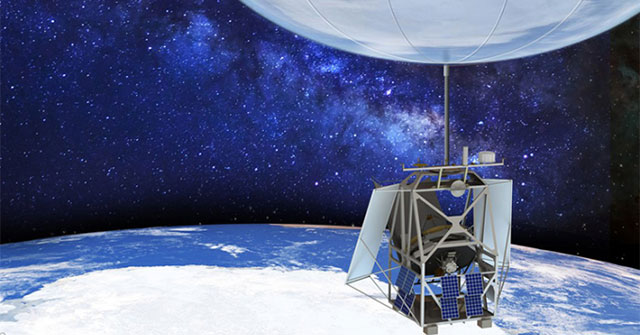A balloon the size of a football field will carry the ASTHROS telescope to observe the universe from Antarctica in December 2023.

Simulation of the ASTHROS telescope hovering above Earth. Photo: NASA/JPL-Caltech
By escaping the obscuring effects of Earth’s atmosphere, space telescopes represent a significant leap in astronomy, allowing humanity to gain deeper insights into the universe. However, the development of such telescopes can take many years, and launching them into space is also very costly.
An alternative solution is to suspend telescopes from balloons, keeping them above most of the atmosphere for observation. This approach is not perfect but is cheaper than launching space telescopes, while also allowing organizations to use them as a testing ground for future space technologies.
In this new mission, NASA will use a football field-sized balloon to carry the ASTHROS telescope to an altitude of 40,000 meters, as reported by New Atlas on July 1. The balloon is expected to launch from Antarctica in December 2023, embarking on a four-week journey over the South Pole while carrying ASTHROS. This telescope is equipped with one of the largest mirrors ever flown on such high-tech balloons.

Primary mirror of the ASTHROS telescope. Photo: Media Lario
NASA states that the telescope mounted on the balloon must be robust. This is particularly crucial for ASTHROS. Its 2.5-meter-wide mirror must withstand both mechanical vibrations and gravitational pull, ensuring that its parabolic shape deviates only within 2.2 micrometers.
To achieve this, Media Lario (Italy) has constructed the primary mirror of ASTHROS from lightweight aluminum panels in a honeycomb structure, with a surface coated in gold-plated nickel. It is mounted on a carbon composite support frame to ensure it is both lightweight and sturdy.
The coating allows the mirror to reflect faint light in the far-infrared wavelengths. This capability enables ASTHROS to observe star-forming regions of the Milky Way and create high-resolution 3D maps of the distribution and movement of gases, while also comparing them with distant galaxies to better understand the processes of star formation and death.
“I think this is probably the most complex telescope ever built for a high-altitude balloon mission. We have specifications similar to space telescopes but with tighter budgets, schedules, and volumes. We have to integrate technology from ground-based telescopes observing at similar wavelengths with advanced technology used for professional racing sailboats,” said Jose Siles, the ASTHROS project manager at NASA’s Jet Propulsion Laboratory (JPL).
ASTHROS is expected to be attached to the equipment compartment of the balloon next month, followed by a testing phase before flight.


















































